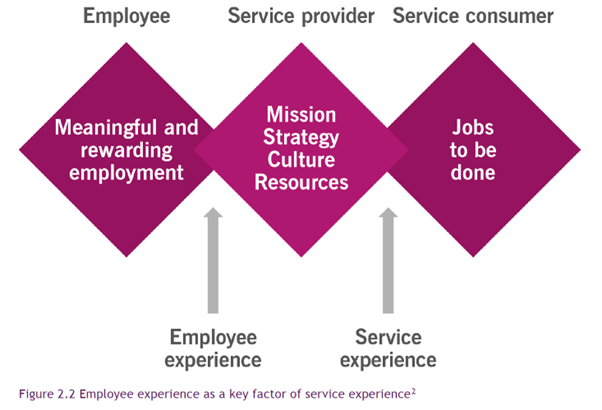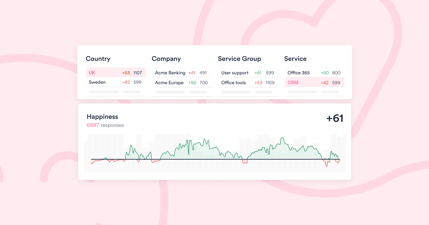ITIL 4 and Employee Experience: The Workforce and Talent Management Practice Guide
This article looks at the ITIL 4 Workforce and Talent Management practice guide and what it shares in regards to experience; and places this in the context of IT service delivery and support to understand what organizations need to do to bring experience management into their existing or future ITSM capabilities.

An earlier article looked at where the commonly-adopted ITIL 4 practices refer to employee experience. Or, as that article shares, where ITIL 4 refers to user experience. However, one ITIL 4 practice guide deviates from the ITIL 4 use of “user experience” to share guidance related to employee experience – this is the workforce and talent management practice guide.
This article looks at what this ITIL 4 practice guide shares regarding experience – spoiler, there’s a lot – and places this in the context of IT service delivery and support to understand what organizations need to do to bring experience management into their existing or future IT service management (ITSM) capabilities.
Employee experience is key to service experience
The workforce and talent management practice guidance states that employee experience is key to service experience. Figure 2.2 from the practice guide is titled “Employee experience as a key factor of service experience”:

So it might be confusing that employee experience isn’t mentioned more in the other ITIL 4 practice guides. But as suggested in the earlier article, it’s likely a timing issue – with the ITIL 4 best practice guidance collated before the rapid rise of employee experience in the IT industry.
Employee experience is front-and-center in the workforce and talent management practice
The workforce and talent management practice guide doesn’t suffer from this omission, with the scope of workforce management relating to employee supply, cost, and experience:
“Workforce management includes:
- ensuring that the organization has enough people to fulfill its plans and accommodate all necessary unplanned work
- ensuring a good balance between the cost of the workforce and the value enabled by the workforce
- ensuring a positive employee experience.”
ITIL 4’s definition of employee experience reflects this broad scope: “The total of the functional and emotional interactions with an organization as perceived by an employee.” It’s a definition more aligned with the human resources (HR) perspective of employee experience than IT’s. But it’s good to see it in the ITIL 4 best practice content, with a more detailed scope definition also including “managing and improving the employees’ journeys and experience.”
Valuing employee experience feedback
Table 2.2 (titled “Employee journey steps”) in the workforce and talent management practice guide “describes the basic activities involved in each step of the employee journey in a generic way.” Within it, the Realize step includes: “Provide feedback about the employee experience.” While the table descriptor states, “These tailored descriptions can be used as models for managing the employee journeys and improving the employee experience.” But as with the other ITIL 4 practices, while assessing and improving the employee experience is called out, it’s up to the adopting organization to decide on its method for doing this.
The workforce and talent management practice also describes employee journey models, which “… aim to ensure value co-creation for the organization and the employee by: creating a positive employee experience …” Again, the shared guidance is very HR-centric (or employee-centric), offering perspectives related to the earlier definition rather than focusing on the IT experience. For example, “The employee experience is created through the physical work environment, social interactions, work interactions, and the essence of work to be done. To improve the employee experience, organizations employ approaches such as personalization, transparency, simplicity, authenticity, and responsiveness.” There’s no mention of the “how” and, critically, the “how” of capturing and benefitting from experience data.
On the one hand, it’s good to understand the experience “bigger picture” for employees, and we need to remember that ITIL 4 relates to service management, not ITSM. For example, HR professionals can use ITIL for employee service management. On the other, however, the absence of ITSM examples of the common employee experience issues and opportunities to improve, and practical guidance, is detrimental to helping organizations appreciate what’s needed, i.e. that experience data is needed to measure and improve the employee experience.
The closest the practice guide gets to this is mapping the ITIL guiding principles to employee experience, shown below.
ITIL guiding principles applied to the employee experience
The following table is replicated from the ITIL 4 workforce and talent management practice guide. It shows how the ITIL guiding principles relate to employee experience.
Table 2.3: ITIL guiding principles applied to the employee experience
|
ITIL guiding principle |
Application to employee experience |
|
Focus on value |
Understand how the employee sees their contribution to the organization’s mission and vision and what value is expected by the organization and its consumers, and ensure that employees have a “clear line of sight” to consumers. Ensure that there is a shared understanding of value. Ensure that the employee’s journey is tailored to optimize the agreed value. |
|
Start where you are |
Take the employee’s previous experiences into account, regardless of whether they were with the same or another organization(s). Account for cultural differences. Ensure effective onboarding. |
|
Progress iteratively with feedback |
Collect and discuss feedback regularly with employees. Actively manage competence and performance development. |
|
Collaborate and promote visibility |
Be transparent and honest with employees, involve them in discussions and important decision-making as often as possible. Create organizational structures that allow for the creation of cross-functional, diverse teams whenever possible. |
|
Think and work holistically |
Ensure that employees have a shared vision of the big picture and that they understand how they contribute to the organization’s success and benefit from it. Analyze and improve all areas of the employee experience (physical, social, and work). |
|
Keep it simple and practical |
Keep procedures, structures, and interactions simple and practical. Avoid excessive bureaucracy. |
|
Optimize and automate |
Keep optimizing work, physical, and social environments and interactions. Automate where possible and beneficial. |
Source: Axelos, Workforce and talent management ITIL 4 Practice guide (2020)
Bringing the value of experience data to the fore
What’s probably most important to IT organizations, in the context of end-user employee experience, in the above table are:
- “Progress iteratively with feedback” which states, “Collect and discuss feedback regularly with employees. Actively manage competence and performance development.”
- “Optimize and automate” which says, “Keep optimizing work, physical, and social environments and interactions. Automate where possible and beneficial.”
On the first read, the former might appear to relate to the experiences of IT employees involved in service delivery and support (which is in itself valuable). However, it also applies to the employees receiving services from the IT organization, with their feedback employed to improve IT capabilities based on what matters most. Once issues and improvement opportunities are known, continual improvement can help optimize service and support capabilities, leveraging automation when appropriate.
In doing this, the aforementioned employee journey management can be used with key employee touchpoints to better understand whether IT is meeting employee needs and where there are issues and improvement opportunities. As the workforce and talent management practice states, “It describes universal activities that aim to ensure that all employee journeys are successful and relevant to the organization’s needs, and ensure a positive employee experience.”
However, this can be suboptimal for high-volume IT processes such as incident and service request management. Because, even when regularly repeated, employee journey mapping/management can miss critical issues and improvement opportunities – particularly when the volume of employees involved is limited.
It’s why HappySignals created its IT Experience Management Platform – where experience data is captured whenever the end-user wants to provide it after their IT experience. For more information on how HappySignals can work alongside ITIL in your organization, please get in touch.
Related content

06.02.2025
What Will It Take To Elevate Employee Experience in Your Organization?
In case you missed it, HappySignals celebrated its tenth birthday last year. It has been a journey we’ve shared with ...
Read more >
29.03.2023
Where the Core ITIL 4 Practices Link to Experience
If your organization understands the importance of experience management to IT service delivery and support, have you ...
Read more >
